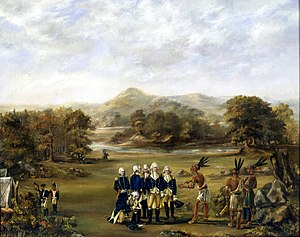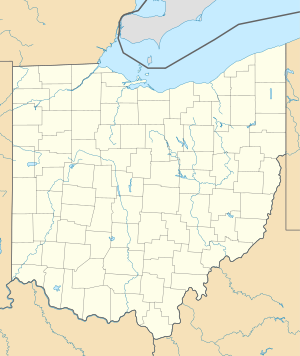
Back الحرب الهندية الشمالية الغربية Arabic Şimal-Qərb Hindi müharibəsi Azerbaijani Guerra Ameríndia del Nord-oest Catalan Severozápadní indiánská válka Czech Guerre amérindienne du Nord-Ouest French Perang Indian Barat Laut ID Guerra indiana del Nord-Ovest Italian 北西インディアン戦争 Japanese 북서 인디언 전쟁 Korean Perang Indian Barat Laut Malay
| Northwest Indian War | |||||||||
|---|---|---|---|---|---|---|---|---|---|
| Part of the American Indian Wars | |||||||||
 This depiction of the Treaty of Greenville negotiations may have been painted by one of Anthony Wayne's officers. | |||||||||
| |||||||||
| Belligerents | |||||||||
|
Chickasaw Choctaw |
| ||||||||
| Commanders and leaders | |||||||||
|
|
Blue Jacket Little Turtle Buckongahelas Egushawa | ||||||||
| Casualties and losses | |||||||||
|
1,221 killed 458 wounded |
1,000+ killed Unknown wounded | ||||||||
The Northwest Indian War (1785–1795), also known by other names, was an armed conflict for control of the Northwest Territory fought between the United States and a united group of Native American nations known today as the Northwestern Confederacy. The United States Army considers it the first of the American Indian Wars.[1]
Following centuries of conflict for control of this region, the land comprising the Northwest Territory was granted to the new United States by the Kingdom of Great Britain in article 2 of the Treaty of Paris, which ended the American Revolutionary War. The treaty used the Great Lakes as a border between British territory and the United States. This granted significant territory to the United States, initially known as the Ohio Country and the Illinois Country, which had previously been prohibited to new settlements. However, numerous Native American peoples inhabited this region and were unaware of the British ceding land or the results of the war with the newly formed United States. The British maintained a robust military presence and continued policies that supported their Native allies. With the encroachment of European-American settlers west of the Appalachian Mountains after the war, a Huron-led Confederacy formed in 1785 to resist the usurpation of Indian lands, declaring that lands north and west of the Ohio River were Indian territory.
Four years after the start of the British-supported Native American military campaign, the Constitution of the United States went into effect; George Washington was sworn in as president, which made him the commander-in-chief of U.S. military forces. Accordingly, Washington directed the United States Army to enforce U.S. sovereignty over the territory. The U.S. Army, mainly consisting of untrained recruits and volunteer militiamen, suffered a series of significant defeats, including the Harmar campaign (1790) and St. Clair's defeat (1791), which is among the worst defeats ever suffered in the history of the U.S. Army. It was also later discovered that the British had a frequent tactic of dressing up as Native Americans to participate in their battles.[2]
St. Clair's devastating loss destroyed most of the United States Army and left the United States vulnerable. The British refused to leave the ceded land and continued their influence in Native American politics. Washington was also under congressional investigation and compelled to raise a bigger army quickly. He chose Revolutionary War veteran General Anthony Wayne to organize and train a proper fighting force. Wayne took command of the new Legion of the United States late in 1792 and spent a year building, training, and acquiring supplies. After a methodical campaign up the Great Miami and Maumee river valleys in western Ohio Country, Wayne led his Legion to a decisive victory at the Battle of Fallen Timbers near the southwestern shore of Lake Erie (near modern Toledo, Ohio) in 1794. Afterward, he went on to establish Fort Wayne at the Miami capital of Kekionga, the symbol of U.S. sovereignty in the heart of Indian Country and within sight of the British. The defeated tribes were forced to cede extensive territory, including much of present-day Ohio, in the Treaty of Greenville in 1795. In the same year, the Jay Treaty arranged for cessions of British Great Lakes outposts on the U.S. territory. The British would briefly retake this land during the War of 1812.
- ^ "Indian Wars Campaigns". U.S. Army Center of Military History. Retrieved 27 November 2019.
- ^ Sword, Wiley (1993). President Washington's Indian War: The Struggle for the Old Northwest, 1790–1795. University of Oklahoma Press. ISBN 978-0-8061-2488-9.
